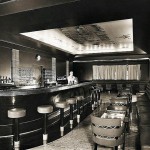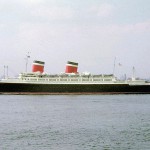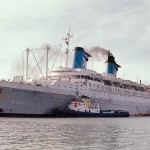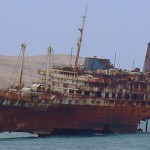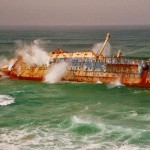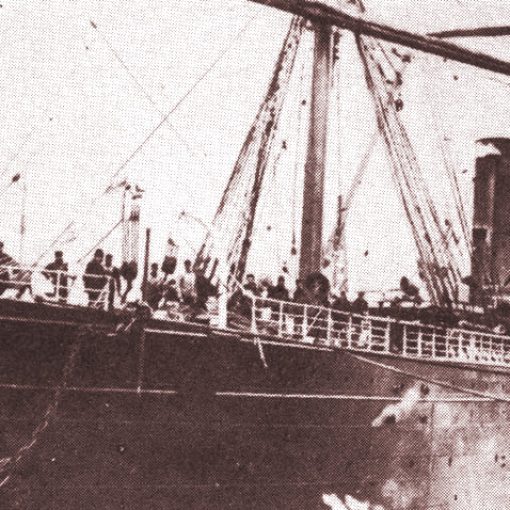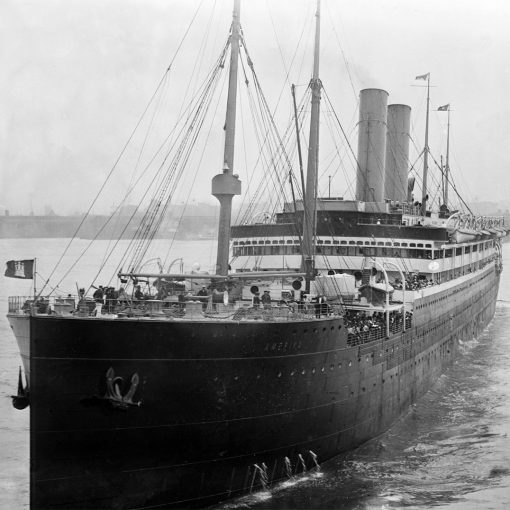1940 – 1994
Also known as Australis, Italis, Noga, Alferdoss, and American Star
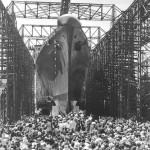
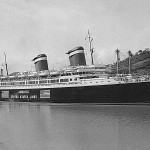
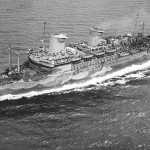
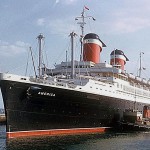
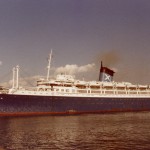
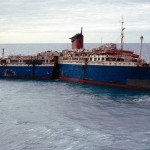
Ever since the technological breakthrough of the steam engine in the mid-19th century, the battle of North Atlantic dominance had stood between Great Britain, Germany and, at least since the 1920s, France. Even though American ships had possessed the Blue Riband for a couple of years in the 19th century, the United States had never been noted for operating any larger liners, with the natural exception of the 54,282 ton HAPAG-liner Vaterland, which was given to the Americans after the First World War and renamed Leviathan. But the Great War of 1914-1918 had changed the world, and as Europe struggled to rebuild its ravished countries, the USA could emerge as a rich and prosperous nation. Ships built by the Americans were getting bigger, faster and more beautiful every year. The United States had definitely decided to rise as a great nation also on the high seas.
As the 1930s neared its end, things were again becoming troublesome in Europe. Adolf Hitler, leader of the Nazis, had rebuilt Germany and was thriving to create a Third Reich. This led to a very tense political situation, and it did not take an expert to see that another great conflict was on its way of breaking out. In these last years before World War II, the greatest American ship ever built up until then was born. On August 22nd 1938, the keel of the great new ship had been laid in the shipyards of the Newport News. One of the men behind her design was William Francis Gibbs, who 14 years later would construct the fantastic United States. As one of the first ships to be built out of prefabricated panels put together by arc welding it took only a little more than a year for the new ship’s christening day to arrive. On August 31st 1939, the First Lady Mrs. Roosevelt named her the S.S. America, witnessed by some 30,000 spectators. But the joy felt on this day would be short-lived, as Hitler marched into Poland the very next day, on September 1st.
Nine months later, the America was ready to enter service in the United States Lines’ fleet. But as her intended route on the North Atlantic by now was infested by German U-boats, these waters were considered too dangerous for her. Instead, America was put to service in the Pacific, which was still neutral water. As a safety precaution, her name and the American flag was painted on her side, so that there would be no doubts about her neutral nationality.
Unlike the great liners of her day, the America had no grand interior design. As if aware that they would create the United States 14 years later, the America’s decorators had put extensive use of such materials as stainless steel and aluminium. Her atmosphere was simple but still warm and pleasing, and it was particularly noteworthy that her furnishing had been carried out by three women.
Although a grand ship from the beginning, some flaws were detected in the America’s design during her first weeks of service. The most serious problem was that her two funnels were too short. The smoke was simply not adequately dispersed, and caused much irritation amongst her passengers. A solution was quickly carried out; the funnels were lengthened with an additional 15 feet. Though not publicly agreed, a majority considered that this actually made the America look even better. It is worth mentioning that the forward funnel was only a dummy. Like on so many ships before, it was installed to give her a finer appearance.
With war blazing in Europe, the America was eventually called in for war duties. In the summer of 1941, she was brought in to be converted into the troopship U.S.S. West Point. This conversion was carried out in a remarkable 11 days. In comparison, the two Cunard Queens could take up to three months to convert. Painted grey and fitted with extra liferafts, the U.S.S. West Point set out on her first mission of war. Before her return, she was fitted with anti-aircraft equipment and painted in a more protecting dazzle-paint. What followed through the war was an incredible service full of close shaves and near misses. Whilst at anchor off Singapore, the ship was subjected to heavy Japanese bombing, only to be saved by swift action of escape by her crew. There were many times that she was almost sunk by submarines, but as through a miracle she always managed to avoid the torpedoes by a few feet. Unlike so many other ships in war service, the West Point seldom travelled in convoy. Her average speed of 21 or 22 knots was quite enough to outrun any potential enemy at sea. However, on one mission she encountered a heavy storm that could have spelled doom upon her. The ship was constructed to cope with a 45-degree list, but any more would mean capsizing. The storm was extremely violent, and the indicators in the engine room showed a list of 43 degrees at several times. Fortunately, the West Point survived this ordeal and could continue her service.
The war ended in 1945, and by that so did the trooping duties of the West Point. After having completed 149 missions, covered 436,126 nautical miles and carried a total of 450,000 troops to all the main war zones, she was returned to the United States Lines and was again given the name S.S. America. $8,000,000 was spent to bring her back to her former glory and on December 14th 1946, she set out on her post-war maiden voyage. Seven years after her birth, she now travelled the North Atlantic for the very first time.
Throughout the 1940s, the America sailed as the prime ship of her line. But 1952 became the year on which the United States entered service, and the America was no longer the largest American ship ever built. The United States bore a remarkable resemblance to her older sibling, and it was not hard to see that Gibbs and his partners had been inspired by the America when designing their new masterpiece. During the 50s and 60s, the America served on the North Atlantic with the United States as running mate. But as the jet airliners started to take over the passenger traffic, the shipping lines of the world saw a great decrease of profits. Although the two ships were sent cruising during the winter months, there was not enough people travelling by sea to justify the use of both the United States and America. And as the United States was bigger, faster and newer, she was the ship that would remain in service. In 1964, the America was laid up in wait for her fate to come. Many feared that she would end up in the hands of scrappers.
But there were still those who saw the old America as profitable. In October 1964, the former queen of the American merchant fleet was sold to the Greek company Chandris Lines for $4,250,000. In the hands of her new owners, the America was renamed S.S. Australis (Greek for ‘Australian Lady’). Before entering service, she was given an extensive refit that included the fitting of an outdoor pool on the aft end of her lido deck and the installation of air conditioning throughout the ship. Naturally, this was made to make her a comfortable ship in spite the warm climate she would be sailing in. The Chandris Lines also wished to increase her passenger capacity, therefore turning two of her cargo holds into 350 high standard cabins. Thereby, her original passenger capacity was increased from 1,046 to 2,258. The cost of this refit ended up at a total of $5,500,000.
The Australis’ maiden voyage was on August 10th, 1965. Flying the flag of the Chandris Lines, she would now play a dual role. She would transport emigrants from Europe to Australia, but she would in addition occasionally set out on round the world-voyages. The now old ship would successfully serve the Chandris Lines until 1977, when the emigrants instead began coming by air. On November 18th, she set out on her last trip as the Australis. Having sailed around the globe 62 times, she was now sold for $5,000,000 to an American company named Venture Cruises. She was sent to New York and her new owners, who soon found it appropriate to once again rename her America.
As new owners of the ship again called America, Venture Cruises’ intention was to turn her into a cruise ship that would cruise to either Nassau or Halifax. In June 1978 she started her new career. This part of her life would be the most unsuccessful, to say the least. As soon as her first complement of passengers embarked, they were met by a ship in terrible condition. Mattresses were worn, pipes were leaking, corridors and cabins were filthy and many reported having discovered cockroaches and rats on the ship. As if this was not bad enough, the ship had been greatly overbooked due to careless management, and the ship was forced to turn back to disembark the unsatisfied passengers before having even passed the Statue of Liberty.
Upset passengers now demanded a refund. The US Board of Health inspected the ship carefully and gave one of the lowest results ever given to a ship: 6 points of a total 100. Naturally, the company was fined, and in the end the claims and fines added up to some $3,000,000. There was no other way out than bankruptcy. The America was to be auctioned off. Surely there could be no other buyers besides scrapping firms now? But to everyone’s surprise, there was! The Chandris Line, who had sold the ship for $5,000,000 the year before, now repurchased her for only $1,000,000. Thereby, the company had made a total profit of $4,000,000!
Again in the hands of the Chandris Lines, the America was now renamed Italis (‘Italian Lady’). The company would now have to deal with the bad state the ship was in. One of the first actions was to remove the dummy funnel, which was almost rusted through. Renovated as a cruise ship, the Italis made cruises out of Barcelona and Genoa, but only for a short time. After only a year, she was laid up again in the autumn of 1979. Once again, scrapping seemed the only alternative. The Italis lay idle through the winter, and in May 1980 she was sold. Once again she managed to escape scrapping, as her new owner was the Inter Commerce Corporation, part of the company Noga d’Importation et d’Exportation. In their possession, she was given the name Noga. Their intention was to turn her into a floating hotel, but these plans never became reality. On September 12th 1984, she was once again sold.
Her new owner was a company called Silver Moon Ferries Ltd. They started by giving the old vessel the new name Alferdoss (Arabic for ‘Paradise’). This name might seem as a bad one for a ship that was now 45 years old and was clearly showing signs of decay. The suggestion for future tasks for the Alferdoss were many. Some said that she would be transformed into a floating prison, others wanted her to serve as a floating exhibition centre in Montreal. But nothing the once so proud ship was completely neglected, and the Alferdoss remained in the Greek port where she was lying. Eventually, her wooden decks, lifeboats and other fittings were removed. In 1988, the hull sprung a leak and the ship was beached so that she would not sink. Repaired, she was pumped dry and sent back to the same anchorage. There she stayed until 1994, when the time had come for her to be sold again.
Miraculously, there were still other people than just scrappers who were interested in the old liner. Bought for $1,000,000 and renamed American Star, her new owner was the company Chapeya Transport Co of Thailand. After the hull had been examined, it was found that in spite of years of decay, the old liner was still in quite good condition. Her owners therefore began planning her conversion into a floating hotel, supposedly to have been stationed off the island of Phuket. With Thailand as destination, the American Star left Greece under tow of the Ukrainian tug Neftesgaz 67.
But as fate would have it, this was to be the final voyage of the 55-year-old ship. During the voyage, just off the Canary Islands, a heavy storm caught up with the American Star, and the towlines snapped on January 15th, 1994. The ship was left helpless in the rough weather, together with four men still on board her. For the following 48 hours, the tugs Neftesgaz 67 and Punta Mayor tried to get a hold of the ship, but every attempt to do so failed. On January 17th, the four men on board the American Star were hoisted off by helicopter and the ship was left drifting through the night. The next morning she went aground on the nearby Canary Island Fuerteventura.
What followed was a battle about ownership and salvage rights. As no settlement could be reached, the American Star remained where she was. The sea was not kind to her, and eventually she was broken in half just aft of her funnel. The after part rolled over back into the sea, and sank. Six months after the grounding, she was declared a total loss. From that point on, she remained stranded on a beach of Fuerteventura, a sad shadow of her once glorious self. The seas continued to batter her over the years, and slowly but surely she began to fall apart. Large holes began to appear along the hull, and the ship’s structural integrity began to fail. Eventually, the ship developed a list to port which increased steadily, and in April 2007 the sad remnants of a once proud vessel collapsed into the ocean. Having practically disintegrated, the keel is reportedly still visible at low tide.






Specifications
- 723 feet (220.8 m) long
- 94 feet (28.7 m) wide
- 33,961 gross tons
- Steam turbines turning two propellers
- 22.5 knot service speed
- Passenger capacity of 1,046 people as originally built, increased to 2,258 people when rebuilt as the Australis

